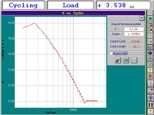|
Automated
Precracking to
international Standards using a choice of compliance, potential drop or
manual techniques for automatic crack measurement
 
The purpose of
precracking is to introduce a defect into a specimen for subsequent
fracture toughness testing or crack growth investigation. In materials
testing, the defect takes the form of a small crack. Ideally, the crack
should have a sharp crack tip with minimal plastic zone surrounding the
crack front because any plasticity in front of the crack face will increase
resistance to crack growth. The ideal precrack can be achieved by:
·
initiating the crack at a high stress intensity factor (Kmax).
·
growing the crack whilst automatically reducing the stress
intensity factor (Kmax) by following a user programmed negative K gradient.
(This technique is also known as load shedding)
- finishing the crack growth
at a constant delta K until the desired crack length is achieved
For further information, please click here.
|